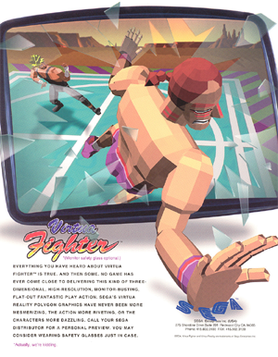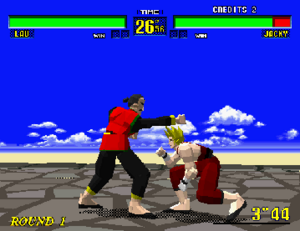Virtua Fighter (video game) facts for kids
Quick facts for kids Virtua Fighter |
|
|---|---|

North American arcade flyer
|
|
| Developer(s) | Sega AM2 |
| Publisher(s) | Sega |
| Director(s) | Yu Suzuki Hideki Anbo (32X) |
| Producer(s) | Yu Suzuki Kouchi Nagata (32X) |
| Designer(s) | Seiichi Ishii Yoshinao Asako, Youji Kato, Ryoya Yui (Saturn) Masashi Kubo (32X) |
| Programmer(s) | Toru Ikebuchi Keiji Okayasu (arcade & Saturn) Hiroaki Shoji Eiji Horita, Akio Setsumasa, Tatsuo Yamajiri, Yasuhiro Takahashi (32X) |
| Composer(s) |
Takayuki Nakamura
Arcade
Takayuki Nakamura Saturn sound design Takayuki Nakamura Takenobu Mitsuyoshi Kazuhiko Kouchi 32X sound design Masaru Setsumaru Tatsuya Kohzaki Atsumu Miyazawa Tadashi Joukagi |
| Series | Virtua Fighter |
| Platform(s) | Arcade, Saturn, 32X, R-Zone, Windows |
| Release date(s) | Arcade
Windows 95 (Remix) |
| Genre(s) | Fighting |
| Mode(s) | Single-player, multiplayer |
| Arcade system | Model 1, ST-V (Remix) |
Virtua Fighter is a super popular fighting game. It was made by Sega AM2, a team at Sega, led by Yu Suzuki. The game first came out in arcades around the world in October 1993.
Virtua Fighter was the very first arcade fighting game to use full 3D polygon graphics. This was a huge deal at the time! It quickly became one of Sega's best-selling arcade games ever. Over 40,000 arcade machines were sold. The home versions for the Sega Saturn also sold more than 1 million copies.
People loved Virtua Fighter because of its deep 3D fighting system. It used real-world fighting moves. This game changed how fighting games were made and influenced many other video games. An updated version, Virtua Fighter Remix, came out in 1995. A remake called Virtua Fighter 10th Anniversary was released in 2003 for the PlayStation 2.
Contents
How to Play Virtua Fighter
Virtua Fighter lets you play in a 3D world. However, your character mostly moves left and right, like in 2D games. The characters and stages are made from simple 3D shapes called polygons.
You pick one of eight characters. Each character has their own special moves. In the single-player game, you fight against all eight characters. You even fight a copy of your own character! After that, you face the final boss, Dural.
Each fight is a "best of three" match. You can win in three ways:
- Knock out your opponent.
- Push them out of the ring.
- Have more health left when time runs out.
Unlike other fighting games from the early 1990s, Virtua Fighter uses only three buttons: punch, kick, and guard (block). But by combining these buttons and using the control stick, each character can do many different moves!
Who Are the Characters?
The game features a cool cast of fighters, each with their own unique style:
- Akira Yuki—A kung fu teacher from Japan. He uses a style called Bajiquan.
- Pai Chan—A movie star from Hong Kong. She fights using Mizongquan.
- Lau Chan—Pai's father and a cook from China. He uses a made-up style called "Tiger Swallow Fist."
- Wolf Hawkfield—A professional wrestler from Canada. He uses wrestling moves.
- Jeffry McWild—A fisherman from Australia. He fights using Pancratium.
- Kage-Maru ("Kage")—A ninja from Japan. He uses Jujutsu.
- Sarah Bryant—A college student from San Francisco. She was kidnapped and brainwashed. She uses Jeet Kune Do.
- Jacky Bryant—Sarah's older brother and a race car driver. He also uses Jeet Kune Do.
- Dural—The final boss. She is a robot and Kage's missing mother. She uses a mix of all the other characters' fighting styles.
There was almost another character named Siba, an Arab fighter. His picture even appeared on some arcade machines! But he was later replaced by Akira Yuki.
What's the Story?
The story of Virtua Fighter is about a big fighting tournament. Fighters from all over the world come to compete. They want to find out who is the best fighter in the world. But behind this tournament, there's a secret plan by a mysterious group.
How Virtua Fighter Was Made
Making the Original Game
Work on Virtua Fighter began in 1992. It was made to run on Sega's special arcade hardware called the Sega Model 1. This game was one of the first to use 3D motion capture technology. This means real people's movements were recorded and used to make the characters move realistically in the game.
Yu Suzuki, the game's director, said that making the 3D calculations fast enough was a big challenge. He compared it to writing 100 words on a single grain of rice! An early version of the game had a different main character, Siba. But Akira Yuki was added later and became the hero.
Virtua Fighter was a very important game for the Sega Saturn console. It was even included for free with the console when it launched in North America!
Virtua Fighter Remix
Virtua Fighter Remix was an updated version of the original game. It had better-looking characters with more detailed 3D models. It also added textures to the characters, making them look even more realistic. Some small changes were made to the gameplay too.
In the United States, Sega gave Virtua Fighter Remix away for free to people who had registered their Sega Saturn consoles. It also came out in arcades and later for Microsoft Windows computers.
Virtua Fighter 10th Anniversary
In 2003, for the series' 10th birthday, a remake called Virtua Fighter 10th Anniversary was released for the PlayStation 2. This version looked like the original game with its simple 3D style. But it used the characters, moves, and fighting system from the newer game, Virtua Fighter 4: Evolution.
In Japan, this game was part of a special box set. In North America, it was included as a bonus with Virtua Fighter 4: Evolution.
Why Virtua Fighter Was So Important
- Further information: Virtua Fighter
Virtua Fighter changed video games forever. Before it, most fighting games used flat, 2D pictures called sprites. Virtua Fighter used real-time 3D polygons. This allowed for amazing things like:
- Characters that could move in all directions (not just left and right).
- A camera that could zoom, pan, and move around the fight.
Many people say Virtua Fighter was the game that started the whole 3D fighting game genre. It also showed everyone how cool 3D polygon characters could be. It even introduced new ideas to fighting games, like getting knocked out of the ring and having a dedicated block button.
At a time when many fighting games were getting very violent, Virtua Fighter showed that games focused on skill and realistic fighting could still be super popular. Even famous game designer Shigeru Miyamoto (who created Mario) said he was so impressed by Virtua Fighter that he didn't want to make fighting games for a while!
Virtua Fighter's simple three-button controls were also praised. The game's strategy came from learning how each character felt and fought differently. The smooth movements and realistic fighting styles made the characters feel alive.
This game also helped make 3D graphics popular in general. Some people who worked on the original PlayStation console said that the success of Virtua Fighter made them decide to focus on 3D graphics for their console. Even the creator of Lara Croft from Tomb Raider said Virtua Fighter influenced her decision to use polygon characters.
See also
 In Spanish: Virtua Fighter para niños
In Spanish: Virtua Fighter para niños


